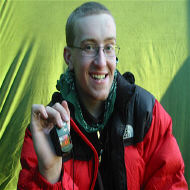Pulse Oximeters – A window to your internal world on the mountain

(Nate showing off his numbers)
My trip to the summit of Kilimanjaro was with Tusker Trail & Safari in 2004.
We climbed the, now closed, Western breach and camped on the crater just an hour below the summit. We had an outstanding adventure.
Along with the oxygen, Gamow bag, lung exams every morning to check for fluids and an evacuation protocol, Tusker, like many others outfitters, used the pulse oximeters.
The device uses mild pressure to check your pulse and a light meter to measure oxygen content in your blood.
I knew how important acclimatization was and I found the little device an excellent confidence builder because we could see that we were adjusting to the altitude, not guessing or wondering.
My son and I also turned it into a game to see who would have the better numbers, as I recall my 17 year old trounced dad (53) pretty regularly.
I had the foresight to photograph the chart the guides kept on me and it shows my daily numbers averaged between 86 and 93 which are very consistent.
The only anomaly was a 63 recorded the day we hiked to Moir Camp from Shira 1. That day was my worst on the entire trip. I’d never been above 12,300 ft. and we went to 13.650 ft. I felt like tossing chow, had a head ache and I’m convinced the whole episode was exacerbated by side effects from the Lariam we took for Malaria prevention because I was paranoid to boot.
Our helpful and diligent guides got me through the day but when I saw the 63 that night a said, “Well no wonder”… The next morning after a good night sleep my number was 96 and I figured I was over the hump. The knowledge I was adjusting really helped my attitude and confidence. I’m glad we had the device along. As it turned out, I never felt rotten again.